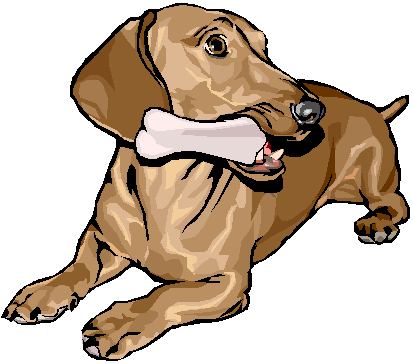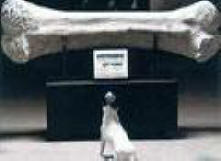Introduction
If used
incorrectly, rawhide chews can
cause intestinal obstruction, and
possible death in dogs. However, when
used correctly, rawhide
chews are a wonderful positive
experience for most dogs, at least for
those without beef allergies.
Watch Video:
Positive Chew Training
Rawhide chew types
Rawhide chews that can
be torn apart are very intriguing to
many dogs. There are other types of
non-rawhide chews that are safer, but
many dogs prefer the rawhides. 
The
chew must be big enough so that
it is impossible to swallow
whole, small enough to be easily
digested by the dog, and should
be given in moderation.
Compressed rawhides last longer.
If the dog buries the toy, a
larger chew can be drilled on
one end, a thin metal chain
passed through the hole and
connected to a post in the yard.
If the dog still buries the
rawhide chew, it is easy to
find!
|
The key to safely using
rawhide chews is careful
selection and training on
how to use chews. |
What to avoid
In
one case, a dog was given a
dozen of the "pencil shaped"
rawhides in one day. This
resulted in intestinal
obstruction and major surgery to
save the dog's life. The smaller
"rolled with twisted knots"
models tend to allow for the end
knot to be easily chewed off and
swallowed. In addition to
avoiding certain sizes and
shapes of rawhides, for safety
purposes, also avoid rawhides
colored with red dye.
Teaching positive chewing
 If
possible, introduce rawhide chews (and other
desirable chew toys) when the dog is still a puppy.
Give rawhides for short periods of time (e.g., 10
minutes), then "trade up." This means request a "sit,"
and offer a tastier treat so that the dog surrenders
the chew voluntarily. Don't allow novice dogs to
chew rawhides unsupervised as they may in fact
swallow too much at once and get sick. Remove and
replace the chew when it is small enough to be
swallowed.
If
possible, introduce rawhide chews (and other
desirable chew toys) when the dog is still a puppy.
Give rawhides for short periods of time (e.g., 10
minutes), then "trade up." This means request a "sit,"
and offer a tastier treat so that the dog surrenders
the chew voluntarily. Don't allow novice dogs to
chew rawhides unsupervised as they may in fact
swallow too much at once and get sick. Remove and
replace the chew when it is small enough to be
swallowed.
The goal behind "Positive Chewing"
is that the dog ENJOYS the positive experience of chewing. This is:
1) Fun for most dogs (pasa tiempo); 2) Dental and Breath cleaning;
3) An energy outlet; 4) an "anxiety" release 5) satisfying to owner
to give dog something enjoyed.
Every dog has a genetic chew tendency from low to
high (Labs are "oral" - like something in their mouth - and
therefore the highest.). Therefore, the first step is testing the
chew potential by offering a variety of chews and simply observe and
document what was chewed and what was rejected.
The next step is to understand the "Chew
Spectrum". Imagine the spectrum from one end (Milk-Bone type
biscuit - usually gone in 2 seconds) up to the other end (e.g. Kong
Super Strong Nylon built to stand nuclear blast). In the middle are
many shades of ease and desirability.
When the dog chews for a while
and then voluntarily leaves the
chew alone, he or she can be
allowed to have chew access for
a longer period of time. If the
dog shows no interest in the
chew, there are strategies to
help the dog who will not chew
on approved objects. Read more
about positive chewing...click
here.